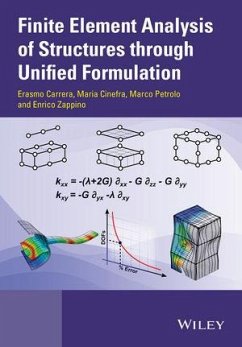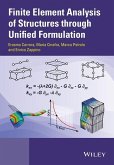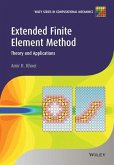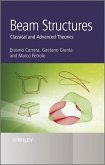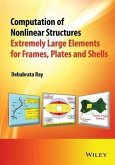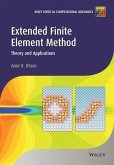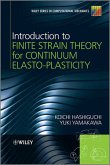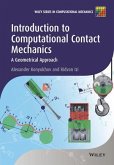Finite Element Analysis of Structures through Unified Formulation (eBook, ePUB)


Alle Infos zum eBook verschenken

Finite Element Analysis of Structures through Unified Formulation (eBook, ePUB)
- Format: ePub
- Merkliste
- Auf die Merkliste
- Bewerten Bewerten
- Teilen
- Produkt teilen
- Produkterinnerung
- Produkterinnerung

Hier können Sie sich einloggen

Bitte loggen Sie sich zunächst in Ihr Kundenkonto ein oder registrieren Sie sich bei bücher.de, um das eBook-Abo tolino select nutzen zu können.
The finite element method (FEM) is a computational tool widely used to design and analyse complex structures. Currently, there are a number of different approaches to analysis using the FEM that vary according to the type of structure being analysed: beams and plates may use 1D or 2D approaches, shells and solids 2D or 3D approaches, and methods that work for one structure are typically not optimized to work for another. Finite Element Analysis of Structures Through Unified Formulation deals with the FEM used for the analysis of the mechanics of structures in the case of linear elasticity. The…mehr
- Geräte: eReader
- mit Kopierschutz
- eBook Hilfe
- Größe: 18.38MB
![Finite Element Analysis of Structures through Unified Formulation (eBook, PDF) Finite Element Analysis of Structures through Unified Formulation (eBook, PDF)]() Erasmo CarreraFinite Element Analysis of Structures through Unified Formulation (eBook, PDF)103,99 €
Erasmo CarreraFinite Element Analysis of Structures through Unified Formulation (eBook, PDF)103,99 €![Extended Finite Element Method (eBook, ePUB) Extended Finite Element Method (eBook, ePUB)]() Amir R. KhoeiExtended Finite Element Method (eBook, ePUB)105,99 €
Amir R. KhoeiExtended Finite Element Method (eBook, ePUB)105,99 €![Beam Structures (eBook, ePUB) Beam Structures (eBook, ePUB)]() Erasmo CarreraBeam Structures (eBook, ePUB)89,99 €
Erasmo CarreraBeam Structures (eBook, ePUB)89,99 €![Computation of Nonlinear Structures (eBook, ePUB) Computation of Nonlinear Structures (eBook, ePUB)]() Debabrata RayComputation of Nonlinear Structures (eBook, ePUB)125,99 €
Debabrata RayComputation of Nonlinear Structures (eBook, ePUB)125,99 €![Extended Finite Element Method (eBook, PDF) Extended Finite Element Method (eBook, PDF)]() Amir R. KhoeiExtended Finite Element Method (eBook, PDF)105,99 €
Amir R. KhoeiExtended Finite Element Method (eBook, PDF)105,99 €![Introduction to Finite Strain Theory for Continuum Elasto-Plasticity (eBook, ePUB) Introduction to Finite Strain Theory for Continuum Elasto-Plasticity (eBook, ePUB)]() Koichi HashiguchiIntroduction to Finite Strain Theory for Continuum Elasto-Plasticity (eBook, ePUB)123,99 €
Koichi HashiguchiIntroduction to Finite Strain Theory for Continuum Elasto-Plasticity (eBook, ePUB)123,99 €![Introduction to Computational Contact Mechanics (eBook, ePUB) Introduction to Computational Contact Mechanics (eBook, ePUB)]() Alexander KonyukhovIntroduction to Computational Contact Mechanics (eBook, ePUB)79,99 €
Alexander KonyukhovIntroduction to Computational Contact Mechanics (eBook, ePUB)79,99 €-
-
-
Dieser Download kann aus rechtlichen Gründen nur mit Rechnungsadresse in A, B, BG, CY, CZ, D, DK, EW, E, FIN, F, GR, HR, H, IRL, I, LT, L, LR, M, NL, PL, P, R, S, SLO, SK ausgeliefert werden.
- Produktdetails
- Verlag: John Wiley & Sons
- Seitenzahl: 416
- Erscheinungstermin: 29. Juli 2014
- Englisch
- ISBN-13: 9781118536650
- Artikelnr.: 41328992
- Verlag: John Wiley & Sons
- Seitenzahl: 416
- Erscheinungstermin: 29. Juli 2014
- Englisch
- ISBN-13: 9781118536650
- Artikelnr.: 41328992
in this book 1 1.2 The finite element method 2 1.2.1 Approximation of the
domain 2 1.2.2 The numerical approximation 4 1.3 Calculation of the area of
a surface with a complex geometry via FEM 5 1.4 Elasticity of a bar 6 1.5
Stiffness matrix of a single bar 8 1.6 Stiffness matrix of a bar via the
Principle of Virtual Displacements 11 1.7 Truss structures and their
automatic calculation by means of FEM 14 1.8 Example of a truss structure
17 1.8.1 Element matrices in the local reference system 18 1.8.2 Element
matrices in the global reference system 18 1.8.3 Global structure stiffness
matrix assembly 19 1.8.4 Application of boundary conditions and the
numerical solution 20 1.9 Outline of the book contents 22 2 Fundamental
equations of three-dimensional elasticity 25 2.1 Equilibrium conditions 25
2.2 Geometrical relations 27 2.3 Hooke's law 27 2.4 Displacement
formulations 28 3 From 3D problems to 2D and 1D problems: theories for
beams, plates and shells 31 3.1 Typical structures 31 3.1.1
Three-dimensional structures, 3D (solids) 32 3.1.2 Two-dimensional
structures, 2D (plates, shells and membranes) 32 3.1.3 One-dimensional
structures, 1D (beams and bars) 33 3.2 Axiomatic method 33 3.2.1 2D case 34
3.2.2 1D Case 37 3.3 Asymptotic method 39 4 Typical FE governing equations
and procedures 41 4.1 Static response analysis 41 4.2 Free vibration
analysis 42 4.3 Dynamic response analysis 43 5 Introduction to the unified
formulation 47 5.1 Stiffness matrix of a bar and the related fundamental
nucleus 47 5.2 Fundamental nucleus for the case of a bar element with
internal nodes 49 5.2.1 The case of an arbitrary defined number of nodes 53
5.3 Combination of FEM and the theory of structure approximations: a four
indices fundamental nucleus and the Carrera unified formulation 54 5.3.1
Fundamental nucleus for a 1D element with a variable axial displacement
over the cross-section 55 5.3.2 Fundamental nucleus for a 1D structure with
a complete displacement field: the case of a refined beam model 56 5.4 CUF
assembly technique 58 5.5 CUF as a unique approach for one-, two- and
three-dimensional structures 59 5.6 Literature review of the CUF 60 6 The
displacement approach via the Principle of Virtual Displacements and FN for
1D, 2D and 3D elements 65 6.1 Strong form of the equilibrium equations via
PVD 65 6.1.1 The two fundamental terms of the fundamental nucleus 69 6.2
Weak form of the solid model using the PVD 69 6.3 Weak form of a solid
element using indicial notation 72 6.4 Fundamental nucleus for 1D, 2D and
3D problems in unique form 73 6.4.1 Three-dimensional models 74 6.4.2
Two-dimensional models 74 6.4.3 One-dimensional models 75 6.5 CUF at a
glance 76 6.5.1 Choice of Ni, Nj, F and Fs 78 7 3D FEM formulation (solid
elements) 81 7.1 An 8-node element using the classical matrix notation 81
7.1.1 Stiffness Matrix 83 7.1.2 Load Vector 84 7.2 Derivation of the
stiffness matrix using the indicial notation 85 7.2.1 Governing equations
86 7.2.2 Finite element approximation in the CUF framework 86 7.2.3
Stiffness matrix 87 7.2.4 Mass matrix 89 7.2.5 Loading vector 90 7.3 3D
numerical integration 91 7.3.1 3D Gauss-Legendre quadrature 91 7.3.2
Isoparametric formulation 92 7.3.3 Reduced integration: shear locking
correction 93 7.4 Shape functions 95 8 1D models with N-order displacement
field, the Taylor Expansion class (TE) 99 8.1 Classical models and the
complete linear expansion case 99 8.1.1 The Euler-Bernoulli beam model
(EBBT) 101 8.1.2 The Timoshenko beam theory (TBT) 102 8.1.3 The complete
linear expansion case 105 8.1.4 A finite element based on N = 1 106 8.2
EBBT, TBT and N = 1 in unified form 107 8.2.1 Unified formulation of N = 1
108 8.2.2 EBBT and TBT as particular cases of N = 1 109 8.3 Carrera unified
formulation for higher-order models 110 8.3.1 N = 3 and N = 4 112 8.3.2
N-order 113 8.4 Governing equations, finite element formulation and the
fundamental nucleus 114 8.4.1 Governing equations 115 8.4.2 Finite element
formulation 116 8.4.3 Stiffness matrix 117 8.4.4 Mass matrix 120 8.4.5
Loading vector 121 8.5 Locking phenomena 122 8.5.1 Poisson locking and its
correction 123 8.5.2 Shear Locking 125 8.6 Numerical applications 126 8.6.1
Structural analysis of a thin-walled cylinder 128 8.6.2 Dynamic response of
compact and thin-walled structures 132 9 1D models with a physical
volume/surface-based geometry and pure displacement variables, the Lagrange
Expansion class (LE) 143 9.1 Physical volume/surface approach 143 9.2
Lagrange polynomials and isoparametric formulation 145 9.2.1 Lagrange
polynomials 147 9.2.2 Isoparametric formulation 150 9.3 LE displacement
fields and cross-section elements 153 9.3.1 Finite element formulation and
fundamental nucleus 156 9.4 Cross-section multi-elements and locally
refined models 159 9.5 Numerical examples 160 9.5.1 Mesh refinement and
convergence analysis 160 9.5.2 Considerations on Poisson's locking 165
9.5.3 Thin-walled structures and open cross-sections 167 9.5.4 Solid-like
geometrical boundary conditions 174 9.6 The Component-Wise approach for
aerospace and civil engineering applications 184 9.6.1 CW for aeronautical
structures 184 9.6.2 CW for civil engineering 197 10 2D plate models with
N-order displacement field, the Taylor expansion class 201 10.1 Classical
models and the complete linear expansion 201 10.1.1 Classical plate theory
203 10.1.2 First-order shear deformation theory 205 10.1.3 The complete
linear expansion case 207 10.1.4 A finite element based on N = 1 207 10.2
CPT, FSDT and N = 1 model in unified form 209 10.2.1 Unified formulation of
N = 1 model 209 10.2.2 CPT and FSDT as particular cases of N = 1 211 10.3
Carrera unified formulation of N-order 211 10.3.1 N = 3 and N = 4 213 10.4
Governing equations, finite element formulation and the fundamental nucleus
213 10.4.1 Governing equations 214 10.4.2 Finite element formulation 215
10.4.3 Stiffness matrix 216 10.4.4 Mass matrix 217 10.4.5 Loading vector
218 10.4.6 Numerical integration 218 10.5 Locking phenomena 220 10.5.1
Poisson locking and its correction 220 10.5.2 Shear locking and its
correction 221 10.6 Numerical Applications 226 11 2D shell models with
N-order displacement field, the Taylor expansion class 231 11.1 Geometry
description 231 11.2 Classical models and unified formulation 234 11.3
Geometrical relations for cylindrical shells 235 11.4 Governing equations,
finite element formulation and the fundamental nucleus 238 11.4.1 Governing
equations 238 11.4.2 Finite element formulation 238 11.5 Membrane and shear
locking phenomenon 239 11.5.1 MITC9 shell element 240 11.5.2 Stiffness
matrix 244 11.6 Numerical applications 247 12 2D models with physical
volume/surface-based geometry and pure displacement variables, the Lagrange
Expansion class (LE) 255 12.1 Physical volume/surface approach 255 12.2
Lagrange expansion model 258 12.3 Numerical examples 259 13 Discussion on
possible best beam, plate and shell diagrams 263 13.1 The Mixed
Axiomatic/Asymptotic Method 263 13.2 Static analysis of beams 267 13.2.1
Influence of the loading conditions 267 13.2.2 Influence of the
cross-section geometry 268 13.2.3 Reduced models vs accuracy 269 13.3 Modal
analysis of beams 271 13.3.1 Influence of the cross-section geometry 271
13.3.2 Influence of the boundary conditions 276 13.4 Static analysis of
plates and shells 276 13.4.1 Influence of the boundary conditions 279
13.4.2 Influence of the loading conditions 280 13.4.3 Influence of the
loading and thickness 283 13.4.4 Influence of the thickness ratio on shells
287 13.5 The best theory diagram 290 14 Mixing variable kinematic models
295 14.1 Coupling variable kinematic models via shared stiffness 296 14.1.1
Application of the shared stiffness method 298 14.2 Coupling variable
kinematic models via the Lagrange multiplier method 299 14.2.1 Application
of the Lagrange multiplier method to variable kinematics models 302 14.3
Coupling variable kinematic models via the Arlequin method 303 14.3.1
Application of the Arlequin method 305 15 Extension to multilayered
structures 307 15.1 Multilayered structures 307 15.2 Theories on
multilayered structures 311 15.2.1 C0z-requirements 312 15.2.2 Refined
theories 312 15.2.3 Zig-Zag theories 313 15.2.4 Layer-Wise theories 314
15.2.5 Mixed theories 315 15.3 Unified formulation for multilayered
structures 315 15.3.1 ESL models 316 15.3.2 Inclusion of Murakami's Zig-Zag
function 316 15.3.3 Layer-Wise theory and Legendre expansion 317 15.3.4
Mixed models with displacement an transverse stress variables 318 15.4
Finite element formulation 319 15.4.1 Assemblage at multi-layer level 320
15.4.2 Selected results 320 15.5 Literature on CUF extended to multilayered
structures 323 16 Extension to multifield problems 329 16.1 Mechanical vs
field loadings 329 16.2 The need for second generation FEs for multifaced
cases 330 16.3 Constitutive equations for multifield problems 331 16.4
Variational statements for multifield problems 334 16.4.1 PVD - Principle
of Virtual Displacements 335 16.4.2 RMVT - Reissner Mixed Variational
Theorem 338 16.5 Use of variational statements to obtained FE equations in
terms of "Fundamental Nuclei" 340 16.5.1 PVD - applications 341 16.5.2 RMVT
- applications 343 16.6 Selected results 346 16.6.1 Mechanical-Electrical
coupling: static analysis of an actuator plate 347 16.6.2
Mechanical-Electrical coupling: comparison between RMVT analyses 349 16.7
Literature on CUF extended to multifield problems 349 A Numerical
integration 357 A.1 Gauss-Legendre quadrature 357 B CUF finite element
models: programming and implementation guidelines 361 B.1 Preprocessing and
input descriptions 361 B.1.1 General FE inputs 362 B.1.2 Specific CUF
inputs 367 B.2 FEM code 371 B.2.1 Stiffness and mass matrix 372 B.2.2
Stiffness and mass matrix numerical examples 377 B.2.3 Constraints and
reduced models 379 B.2.4 Load vector 382 B.3 Postprocessing 384 B.3.1
Stresses and strains 385 References 386
in this book 1 1.2 The finite element method 2 1.2.1 Approximation of the
domain 2 1.2.2 The numerical approximation 4 1.3 Calculation of the area of
a surface with a complex geometry via FEM 5 1.4 Elasticity of a bar 6 1.5
Stiffness matrix of a single bar 8 1.6 Stiffness matrix of a bar via the
Principle of Virtual Displacements 11 1.7 Truss structures and their
automatic calculation by means of FEM 14 1.8 Example of a truss structure
17 1.8.1 Element matrices in the local reference system 18 1.8.2 Element
matrices in the global reference system 18 1.8.3 Global structure stiffness
matrix assembly 19 1.8.4 Application of boundary conditions and the
numerical solution 20 1.9 Outline of the book contents 22 2 Fundamental
equations of three-dimensional elasticity 25 2.1 Equilibrium conditions 25
2.2 Geometrical relations 27 2.3 Hooke's law 27 2.4 Displacement
formulations 28 3 From 3D problems to 2D and 1D problems: theories for
beams, plates and shells 31 3.1 Typical structures 31 3.1.1
Three-dimensional structures, 3D (solids) 32 3.1.2 Two-dimensional
structures, 2D (plates, shells and membranes) 32 3.1.3 One-dimensional
structures, 1D (beams and bars) 33 3.2 Axiomatic method 33 3.2.1 2D case 34
3.2.2 1D Case 37 3.3 Asymptotic method 39 4 Typical FE governing equations
and procedures 41 4.1 Static response analysis 41 4.2 Free vibration
analysis 42 4.3 Dynamic response analysis 43 5 Introduction to the unified
formulation 47 5.1 Stiffness matrix of a bar and the related fundamental
nucleus 47 5.2 Fundamental nucleus for the case of a bar element with
internal nodes 49 5.2.1 The case of an arbitrary defined number of nodes 53
5.3 Combination of FEM and the theory of structure approximations: a four
indices fundamental nucleus and the Carrera unified formulation 54 5.3.1
Fundamental nucleus for a 1D element with a variable axial displacement
over the cross-section 55 5.3.2 Fundamental nucleus for a 1D structure with
a complete displacement field: the case of a refined beam model 56 5.4 CUF
assembly technique 58 5.5 CUF as a unique approach for one-, two- and
three-dimensional structures 59 5.6 Literature review of the CUF 60 6 The
displacement approach via the Principle of Virtual Displacements and FN for
1D, 2D and 3D elements 65 6.1 Strong form of the equilibrium equations via
PVD 65 6.1.1 The two fundamental terms of the fundamental nucleus 69 6.2
Weak form of the solid model using the PVD 69 6.3 Weak form of a solid
element using indicial notation 72 6.4 Fundamental nucleus for 1D, 2D and
3D problems in unique form 73 6.4.1 Three-dimensional models 74 6.4.2
Two-dimensional models 74 6.4.3 One-dimensional models 75 6.5 CUF at a
glance 76 6.5.1 Choice of Ni, Nj, F and Fs 78 7 3D FEM formulation (solid
elements) 81 7.1 An 8-node element using the classical matrix notation 81
7.1.1 Stiffness Matrix 83 7.1.2 Load Vector 84 7.2 Derivation of the
stiffness matrix using the indicial notation 85 7.2.1 Governing equations
86 7.2.2 Finite element approximation in the CUF framework 86 7.2.3
Stiffness matrix 87 7.2.4 Mass matrix 89 7.2.5 Loading vector 90 7.3 3D
numerical integration 91 7.3.1 3D Gauss-Legendre quadrature 91 7.3.2
Isoparametric formulation 92 7.3.3 Reduced integration: shear locking
correction 93 7.4 Shape functions 95 8 1D models with N-order displacement
field, the Taylor Expansion class (TE) 99 8.1 Classical models and the
complete linear expansion case 99 8.1.1 The Euler-Bernoulli beam model
(EBBT) 101 8.1.2 The Timoshenko beam theory (TBT) 102 8.1.3 The complete
linear expansion case 105 8.1.4 A finite element based on N = 1 106 8.2
EBBT, TBT and N = 1 in unified form 107 8.2.1 Unified formulation of N = 1
108 8.2.2 EBBT and TBT as particular cases of N = 1 109 8.3 Carrera unified
formulation for higher-order models 110 8.3.1 N = 3 and N = 4 112 8.3.2
N-order 113 8.4 Governing equations, finite element formulation and the
fundamental nucleus 114 8.4.1 Governing equations 115 8.4.2 Finite element
formulation 116 8.4.3 Stiffness matrix 117 8.4.4 Mass matrix 120 8.4.5
Loading vector 121 8.5 Locking phenomena 122 8.5.1 Poisson locking and its
correction 123 8.5.2 Shear Locking 125 8.6 Numerical applications 126 8.6.1
Structural analysis of a thin-walled cylinder 128 8.6.2 Dynamic response of
compact and thin-walled structures 132 9 1D models with a physical
volume/surface-based geometry and pure displacement variables, the Lagrange
Expansion class (LE) 143 9.1 Physical volume/surface approach 143 9.2
Lagrange polynomials and isoparametric formulation 145 9.2.1 Lagrange
polynomials 147 9.2.2 Isoparametric formulation 150 9.3 LE displacement
fields and cross-section elements 153 9.3.1 Finite element formulation and
fundamental nucleus 156 9.4 Cross-section multi-elements and locally
refined models 159 9.5 Numerical examples 160 9.5.1 Mesh refinement and
convergence analysis 160 9.5.2 Considerations on Poisson's locking 165
9.5.3 Thin-walled structures and open cross-sections 167 9.5.4 Solid-like
geometrical boundary conditions 174 9.6 The Component-Wise approach for
aerospace and civil engineering applications 184 9.6.1 CW for aeronautical
structures 184 9.6.2 CW for civil engineering 197 10 2D plate models with
N-order displacement field, the Taylor expansion class 201 10.1 Classical
models and the complete linear expansion 201 10.1.1 Classical plate theory
203 10.1.2 First-order shear deformation theory 205 10.1.3 The complete
linear expansion case 207 10.1.4 A finite element based on N = 1 207 10.2
CPT, FSDT and N = 1 model in unified form 209 10.2.1 Unified formulation of
N = 1 model 209 10.2.2 CPT and FSDT as particular cases of N = 1 211 10.3
Carrera unified formulation of N-order 211 10.3.1 N = 3 and N = 4 213 10.4
Governing equations, finite element formulation and the fundamental nucleus
213 10.4.1 Governing equations 214 10.4.2 Finite element formulation 215
10.4.3 Stiffness matrix 216 10.4.4 Mass matrix 217 10.4.5 Loading vector
218 10.4.6 Numerical integration 218 10.5 Locking phenomena 220 10.5.1
Poisson locking and its correction 220 10.5.2 Shear locking and its
correction 221 10.6 Numerical Applications 226 11 2D shell models with
N-order displacement field, the Taylor expansion class 231 11.1 Geometry
description 231 11.2 Classical models and unified formulation 234 11.3
Geometrical relations for cylindrical shells 235 11.4 Governing equations,
finite element formulation and the fundamental nucleus 238 11.4.1 Governing
equations 238 11.4.2 Finite element formulation 238 11.5 Membrane and shear
locking phenomenon 239 11.5.1 MITC9 shell element 240 11.5.2 Stiffness
matrix 244 11.6 Numerical applications 247 12 2D models with physical
volume/surface-based geometry and pure displacement variables, the Lagrange
Expansion class (LE) 255 12.1 Physical volume/surface approach 255 12.2
Lagrange expansion model 258 12.3 Numerical examples 259 13 Discussion on
possible best beam, plate and shell diagrams 263 13.1 The Mixed
Axiomatic/Asymptotic Method 263 13.2 Static analysis of beams 267 13.2.1
Influence of the loading conditions 267 13.2.2 Influence of the
cross-section geometry 268 13.2.3 Reduced models vs accuracy 269 13.3 Modal
analysis of beams 271 13.3.1 Influence of the cross-section geometry 271
13.3.2 Influence of the boundary conditions 276 13.4 Static analysis of
plates and shells 276 13.4.1 Influence of the boundary conditions 279
13.4.2 Influence of the loading conditions 280 13.4.3 Influence of the
loading and thickness 283 13.4.4 Influence of the thickness ratio on shells
287 13.5 The best theory diagram 290 14 Mixing variable kinematic models
295 14.1 Coupling variable kinematic models via shared stiffness 296 14.1.1
Application of the shared stiffness method 298 14.2 Coupling variable
kinematic models via the Lagrange multiplier method 299 14.2.1 Application
of the Lagrange multiplier method to variable kinematics models 302 14.3
Coupling variable kinematic models via the Arlequin method 303 14.3.1
Application of the Arlequin method 305 15 Extension to multilayered
structures 307 15.1 Multilayered structures 307 15.2 Theories on
multilayered structures 311 15.2.1 C0z-requirements 312 15.2.2 Refined
theories 312 15.2.3 Zig-Zag theories 313 15.2.4 Layer-Wise theories 314
15.2.5 Mixed theories 315 15.3 Unified formulation for multilayered
structures 315 15.3.1 ESL models 316 15.3.2 Inclusion of Murakami's Zig-Zag
function 316 15.3.3 Layer-Wise theory and Legendre expansion 317 15.3.4
Mixed models with displacement an transverse stress variables 318 15.4
Finite element formulation 319 15.4.1 Assemblage at multi-layer level 320
15.4.2 Selected results 320 15.5 Literature on CUF extended to multilayered
structures 323 16 Extension to multifield problems 329 16.1 Mechanical vs
field loadings 329 16.2 The need for second generation FEs for multifaced
cases 330 16.3 Constitutive equations for multifield problems 331 16.4
Variational statements for multifield problems 334 16.4.1 PVD - Principle
of Virtual Displacements 335 16.4.2 RMVT - Reissner Mixed Variational
Theorem 338 16.5 Use of variational statements to obtained FE equations in
terms of "Fundamental Nuclei" 340 16.5.1 PVD - applications 341 16.5.2 RMVT
- applications 343 16.6 Selected results 346 16.6.1 Mechanical-Electrical
coupling: static analysis of an actuator plate 347 16.6.2
Mechanical-Electrical coupling: comparison between RMVT analyses 349 16.7
Literature on CUF extended to multifield problems 349 A Numerical
integration 357 A.1 Gauss-Legendre quadrature 357 B CUF finite element
models: programming and implementation guidelines 361 B.1 Preprocessing and
input descriptions 361 B.1.1 General FE inputs 362 B.1.2 Specific CUF
inputs 367 B.2 FEM code 371 B.2.1 Stiffness and mass matrix 372 B.2.2
Stiffness and mass matrix numerical examples 377 B.2.3 Constraints and
reduced models 379 B.2.4 Load vector 382 B.3 Postprocessing 384 B.3.1
Stresses and strains 385 References 386
